sensor TOYOTA COROLLA HATCHBACK 2019 Owners Manual (in English)
[x] Cancel search | Manufacturer: TOYOTA, Model Year: 2019, Model line: COROLLA HATCHBACK, Model: TOYOTA COROLLA HATCHBACK 2019Pages: 56, PDF Size: 5.71 MB
Page 3 of 56
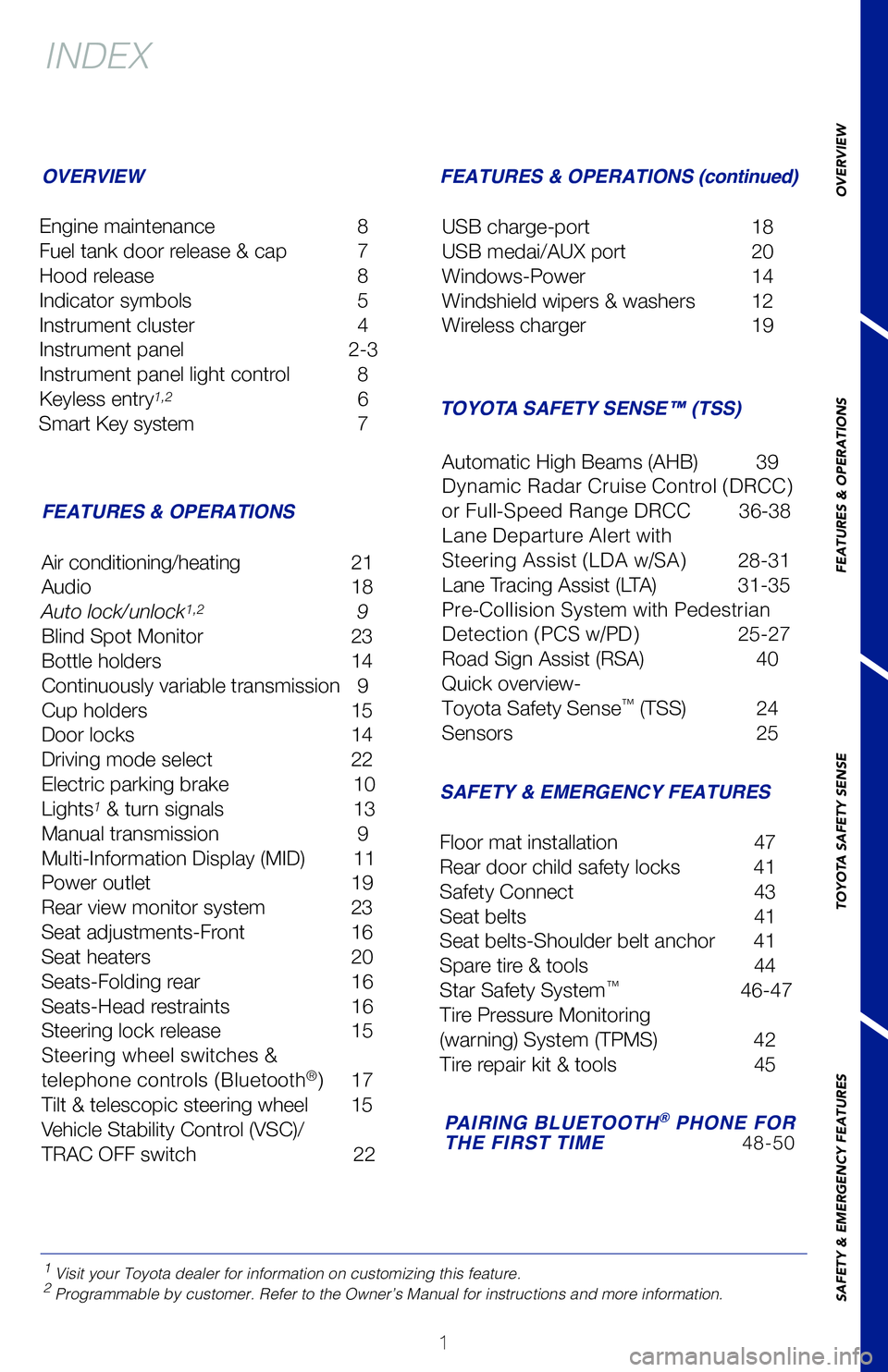
1
1 Visit your Toyota dealer for information on customizing this feature.2 Programmable by customer. Refer to the Owner’s Manual for instructio\
ns and more information.
INDEX
Engine maintenance 8
Fuel tank door release & cap 7
Hood release 8
Indicator symbols 5
Instrument cluster 4
Instrument panel 2-3
Instrument panel light control 8
Keyless entry
1,2 6
Smart Key system 7
OVERVIEW
FEATURES & OPERATIONS FEATURES & OPERATIONS (continued)
TOYOTA SAFETY SENSE™ (TSS)
SAFETY & EMERGENCY FEATURES
Air conditioning/heating
21
Audio 18
Auto lock/unlock
1,2 9
Blind Spot Monitor 23
Bottle holders 14
Continuously variable transmission 9
Cup holders 15
Door locks 14
Driving mode select 22
Electric parking brake 10
Lights
1 & turn signals 13
Manual transmission 9
Multi-Information Display (MID) 11
Power outlet 19
Rear view monitor system 23
Seat adjustments-Front 16
Seat heaters 20
Seats-Folding rear 16
Seats-Head restraints 16
Steering lock release 15
Steering wheel switches &
telephone controls (Bluetooth
®) 17
Tilt & telescopic steering wheel 15
Vehicle Stability Control (VSC)/
TRAC OFF switch 22USB charge-port
18
USB medai/AUX port 20
Windows-Power 14
Windshield wipers & washers 12
Wireless charger 19
Floor mat installation 47
Rear door child safety locks 41
Safety Connect 43
Seat belts 41
Seat belts-Shoulder belt anchor 41
Spare tire & tools 44
Star Safety System
™ 46-47
Tire Pressure Monitoring
(warning) System (TPMS) 42
Tire repair kit & tools 45
Automatic High Beams (AHB) 39
Dynamic Radar Cruise Control (DRCC)
or Full-Speed Range DRCC
36-38
Lane Departure Alert with
Steering Assist (LDA w/SA) 28-31
Lane Tracing Assist (LTA) 31-35
Pre-Collision System with Pedestrian
Detection (PCS w/PD) 25-27
Road Sign Assist (RSA) 40
Quick overview-
Toyota Safety Sense
™ (TSS) 24
Sensors 25
PAIRING BLUETOOTH® PHONE FOR
THE FIRST TIME 48-50
OVERVIEW
FEATURES & OPERATIONS
TOYOTA SAFETY SENSE
SAFETY & EMERGENCY FEATURES
2019_Corolla_HB_QRG_V5_0516.indd 15/17/18 11:26 PM
Page 24 of 56
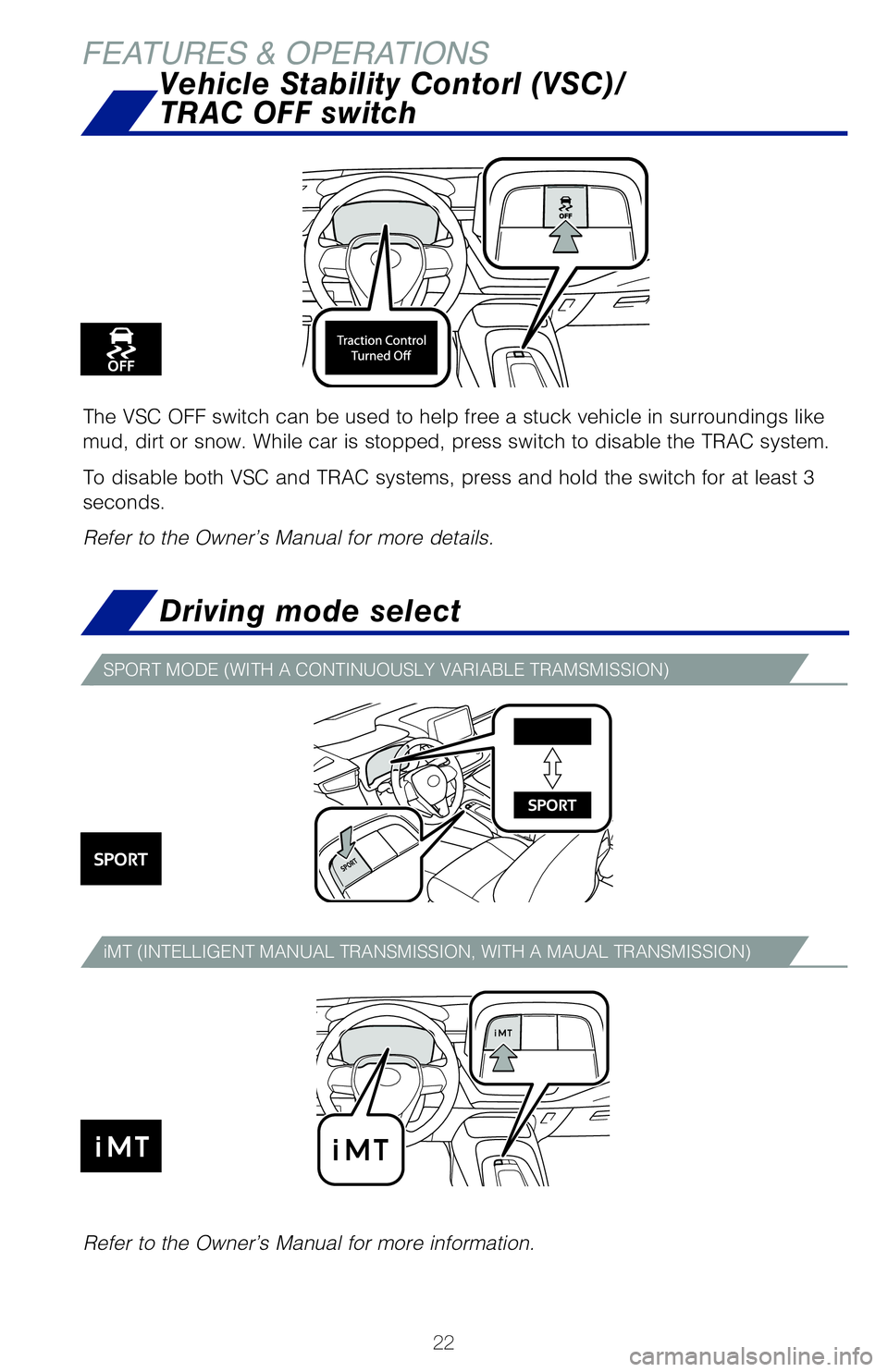
22
FEATURES & OPERATIONSDriving mode select
The rear view monitor system displays an image of the view from the bump\
er of
the rear area of the vehicle. The camera for the rear view monitor syste\
m is located
above the license plate.
To adjust the image on the rear view monitor screen, press the “MENU”\
button and
select “Display” on the screen. Select “Camera” to adjust th\
e screen contrast and
brightness.
Refer to the Owner’s Manual and the Navigation Owner‘s Manual for \
limitations and
more details on this system.
The system is designed to use radar sensors to detect vehicles traveling\
in the
Corolla Hatchback’s blind spot and advises the driver of the vehicles\
’ presence via
the outside rear view mirror indicators.
Refer to the Owner‘s Manual for limitations and more details on this \
system before
attempting to use it.
Outside rear view mirror indicators
iMT (INTELLIGENT MANUAL TRANSMISSION, WITH A MAUAL TRANSMISSION)
SPORT MODE (WITH A CONTINUOUSLY VARIABLE TRAMSMISSION)
Refer to the Owner’s Manual for more information.
Vehicle Stability Contorl (VSC)/
TRAC OFF switch
The VSC OFF switch can be used to help free a stuck vehicle in surroundi\
ngs like
mud, dirt or snow. While car is stopped, press switch to disable the TRA\
C system.
To disable both VSC and TRAC systems, press and hold the switch for at l\
east 3
seconds.
Refer to the Owner’s Manual for more details.
2019_Corolla_HB_QRG_V5_0516.indd 225/17/18 11:12 PM
Page 25 of 56
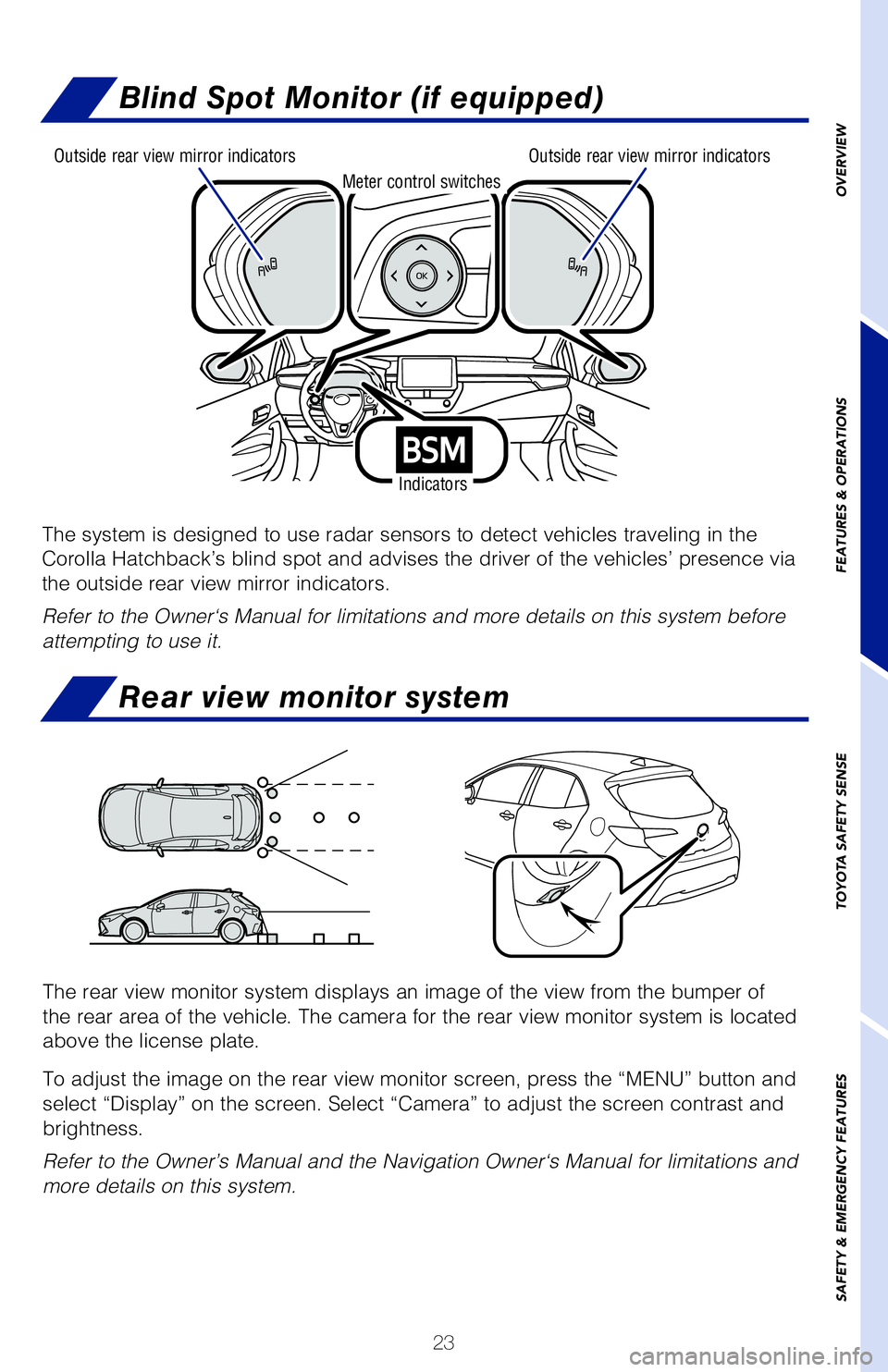
23
OVERVIEW
FEATURES & OPERATIONS
TOYOTA SAFETY SENSE
SAFETY & EMERGENCY FEATURES
Driving mode select
Rear view monitor system
The rear view monitor system displays an image of the view from the bump\
er of
the rear area of the vehicle. The camera for the rear view monitor syste\
m is located
above the license plate.
To adjust the image on the rear view monitor screen, press the “MENU”\
button and
select “Display” on the screen. Select “Camera” to adjust th\
e screen contrast and
brightness.
Refer to the Owner’s Manual and the Navigation Owner‘s Manual for \
limitations and
more details on this system.
The system is designed to use radar sensors to detect vehicles traveling\
in the
Corolla Hatchback’s blind spot and advises the driver of the vehicles\
’ presence via
the outside rear view mirror indicators.
Refer to the Owner‘s Manual for limitations and more details on this \
system before
attempting to use it.
Indicators
Outside rear view mirror indicators
Meter control switches
Outside rear view mirror indicators
Blind Spot Monitor (if equipped)
Refer to the Owner’s Manual for more information.
Vehicle Stability Contorl (VSC)/
TRAC OFF switch
The VSC OFF switch can be used to help free a stuck vehicle in surroundi\
ngs like
mud, dirt or snow. While car is stopped, press switch to disable the TRA\
C system.
To disable both VSC and TRAC systems, press and hold the switch for at l\
east 3
seconds.
Refer to the Owner’s Manual for more details.
2019_Corolla_HB_QRG_V5_0516.indd 235/17/18 11:12 PM
Page 26 of 56
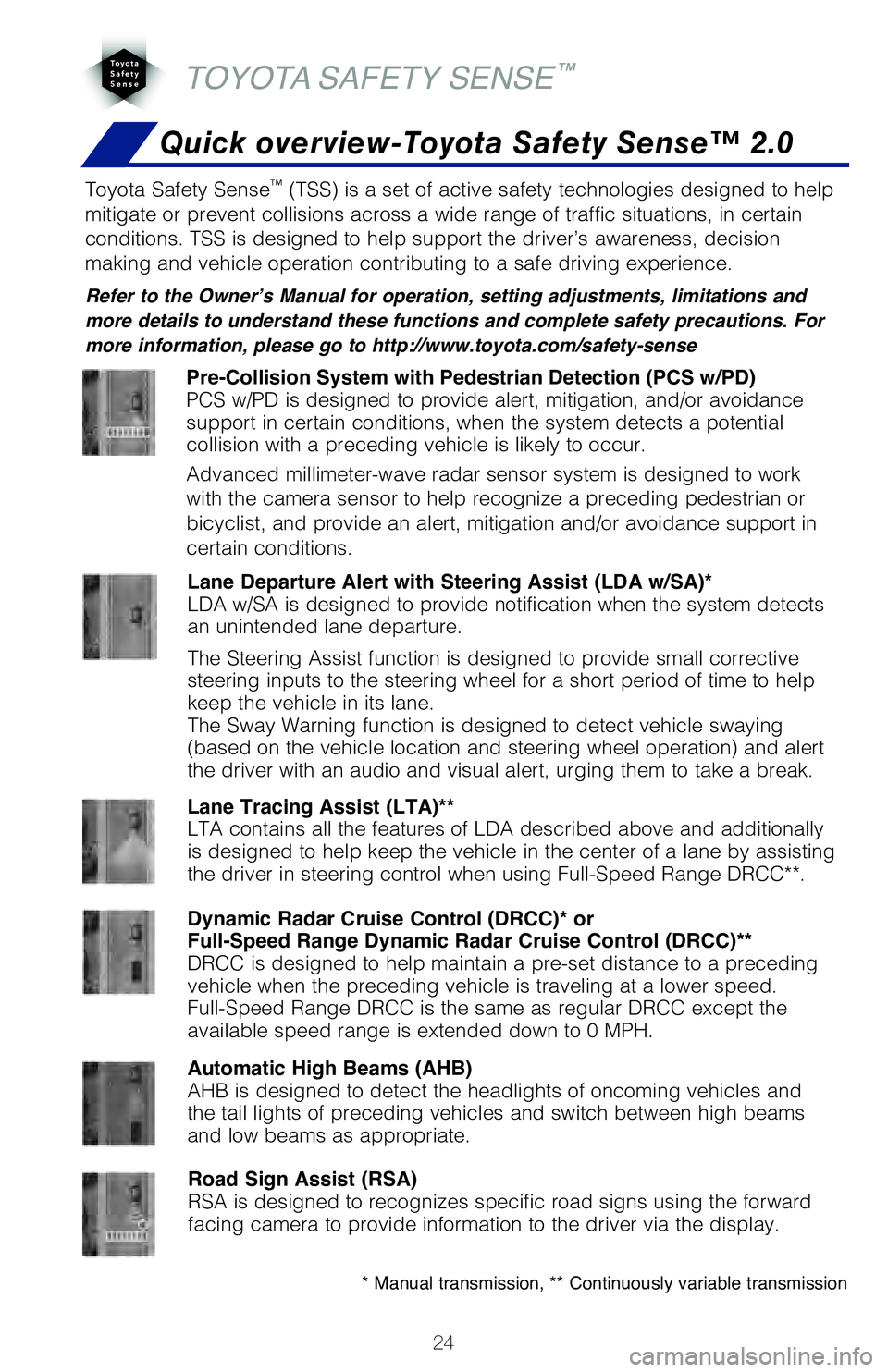
24
TOYOTA SAFETY SENSE™
Toyota Safety Sense™ (TSS) is a set of active safety technologies designed to help
mitigate or prevent collisions across a wide range of traffic situations\
, in certain
conditions. TSS is designed to help support the driver’s awareness, d\
ecision
making and vehicle operation contributing to a safe driving experience.
Refer to the Owner’s Manual for operation, setting adjustments, limitations and
more details to understand these functions and complete safety precautions. For
more information, please go to http://www.toyota.com/safety-sense
TSS-P combines an in-vehicle camera mounted in front of the inside rear \
view mirror
and a radar mounted in the front grill. These sensors support the driver\
assist systems.
The Pre-Collision System uses a radar sensor and camera sensor to help d\
etect a
vehicle or pedestrian or bicyclist in front of your vehicle.
As there is a limit to the degree of recognition accuracy and control pe\
rformance that
this system can provide, do not overly rely on this system. This system \
will not prevent
collisions or lessen collision damage or injury in every situation. Do n\
ot use PCS
instead of normal braking operations under any circumstances. Do not att\
empt to test
the operation of the Pre-Collision System yourself, as the system may no\
t operate or
engage, possibly leading to an accident. In some situations, such as whe\
n driving in
inclement weather such as heavy rain, fog, snow or a sandstorm or while \
driving on a
curve and for a few seconds after driving on a curve, a vehicle may not \
be detected
by the radar and camera sensors, preventing the system from operating or\
engaging
properly.
Refer to a Toyota Owner’s Manual for a list of additional situations \
in which the
system may not operate properly. Pre-Collision Warning
When the system determines that the possibility of a frontal collision i\
s high, a buzzer
will sound and a warning message will be displayed on the Multi-Informat\
ion Display
(MID) to urge the driver to take evasive action.
Pre-Collision Brake Assist
If the driver notices the hazard and brakes, the system may provide addi\
tional braking
force using Brake Assist. This system may prime the brakes and may apply\
greater
braking force in relation to how strongly the brake pedal is depressed.Quick overview-Toyota Safety Sense™ 2.0
Lane Departure Alert with Steering Assist (LDA w/SA)*
LDA w/SA is designed to provide notification when the system detects
an unintended lane departure.
The Steering Assist function is designed to provide small corrective
steering inputs to the steering wheel for a short period of time to help\
keep the vehicle in its lane.
The Sway Warning function is designed to detect vehicle swaying
(based on the vehicle location and steering wheel operation) and alert\
the driver with an audio and visual alert, urging them to take a break.
Automatic High Beams (AHB)
AHB is designed to detect the headlights of oncoming vehicles and
the tail lights of preceding vehicles and switch between high beams
and low beams as appropriate. Road Sign Assist (RSA)
RSA is designed to recognizes specific road signs using the forward
facing camera to provide information to the driver via the display.
Pre-Collision System with Pedestrian Detection (PCS w/PD)
PCS w/PD is designed to provide alert, mitigation, and/or avoidance
support in certain conditions, when the system detects a potential
collision with a preceding vehicle is likely to occur.
Advanced millimeter-wave radar sensor system is designed to work
with the camera sensor to help recognize a preceding pedestrian or
bicyclist, and provide an alert, mitigation and/or avoidance support in \
certain conditions.
Dynamic Radar Cruise Control (DRCC)* or
Full-Speed Range Dynamic Radar Cruise Control (DRCC)**
DRCC is designed to help maintain a pre-set distance to a preceding
vehicle when the preceding vehicle is traveling at a lower speed.
Full-Speed Range DRCC is the same as regular DRCC except the
available speed range is extended down to 0 MPH.
Lane Tracing Assist (LTA)**
LTA contains all the features of LDA described above and additionally
is designed to help keep the vehicle in the center of a lane by assistin\
g
the driver in steering control when using Full-Speed Range DRCC**.
* Manual transmission, ** Continuously variable transmission
2019_Corolla_HB_QRG_V5_0516.indd 245/17/18 11:12 PM
Page 27 of 56
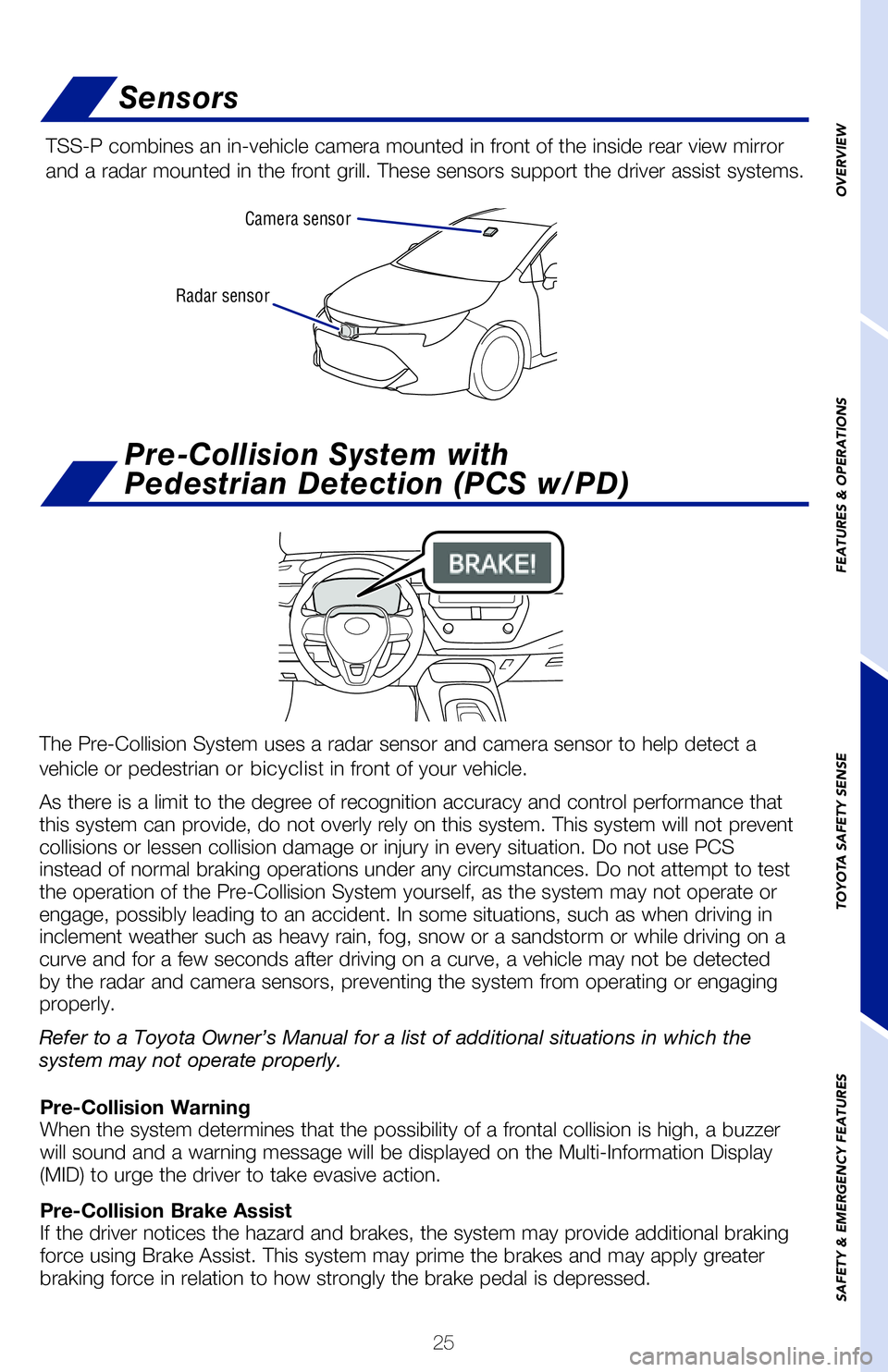
25
OVERVIEW
FEATURES & OPERATIONS
TOYOTA SAFETY SENSE
SAFETY & EMERGENCY FEATURES
Radar sensor Camera sensor
Sensors
Toyota Safety Sense™ (TSS) is a set of active safety technologies designed to help
mitigate or prevent collisions across a wide range of traffic situations\
, in certain
conditions. TSS is designed to help support the driver’s awareness, d\
ecision
making and vehicle operation contributing to a safe driving experience.
Refer to the Owner’s Manual for operation, setting adjustments, limitations and
more details to understand these functions and complete safety precautions. For
more information, please go to http://www.toyota.com/safety-sense
TSS-P combines an in-vehicle camera mounted in front of the inside rear \
view mirror
and a radar mounted in the front grill. These sensors support the driver\
assist systems.
The Pre-Collision System uses a radar sensor and camera sensor to help d\
etect a
vehicle or pedestrian or bicyclist in front of your vehicle.
As there is a limit to the degree of recognition accuracy and control pe\
rformance that
this system can provide, do not overly rely on this system. This system \
will not prevent
collisions or lessen collision damage or injury in every situation. Do n\
ot use PCS
instead of normal braking operations under any circumstances. Do not att\
empt to test
the operation of the Pre-Collision System yourself, as the system may no\
t operate or
engage, possibly leading to an accident. In some situations, such as whe\
n driving in
inclement weather such as heavy rain, fog, snow or a sandstorm or while \
driving on a
curve and for a few seconds after driving on a curve, a vehicle may not \
be detected
by the radar and camera sensors, preventing the system from operating or\
engaging
properly.
Refer to a Toyota Owner’s Manual for a list of additional situations \
in which the
system may not operate properly.
Pre-Collision Warning
When the system determines that the possibility of a frontal collision i\
s high, a buzzer
will sound and a warning message will be displayed on the Multi-Informat\
ion Display
(MID) to urge the driver to take evasive action.
Pre-Collision Brake Assist
If the driver notices the hazard and brakes, the system may provide addi\
tional braking
force using Brake Assist. This system may prime the brakes and may apply\
greater
braking force in relation to how strongly the brake pedal is depressed.
Quick overview-Toyota Safety Sense™ 2.0
Lane Departure Alert with Steering Assist (LDA w/SA)*
LDA w/SA is designed to provide notification when the system detects
an unintended lane departure.
The Steering Assist function is designed to provide small corrective
steering inputs to the steering wheel for a short period of time to help\
keep the vehicle in its lane.
The Sway Warning function is designed to detect vehicle swaying
(based on the vehicle location and steering wheel operation) and alert\
the driver with an audio and visual alert, urging them to take a break.
Automatic High Beams (AHB)
AHB is designed to detect the headlights of oncoming vehicles and
the tail lights of preceding vehicles and switch between high beams
and low beams as appropriate. Road Sign Assist (RSA)
RSA is designed to recognizes specific road signs using the forward
facing camera to provide information to the driver via the display.
Pre-Collision System with Pedestrian Detection (PCS w/PD)
PCS w/PD is designed to provide alert, mitigation, and/or avoidance
support in certain conditions, when the system detects a potential
collision with a preceding vehicle is likely to occur.
Advanced millimeter-wave radar sensor system is designed to work
with the camera sensor to help recognize a preceding pedestrian or
bicyclist, and provide an alert, mitigation and/or avoidance support in \
certain conditions.
Dynamic Radar Cruise Control (DRCC)* or
Full-Speed Range Dynamic Radar Cruise Control (DRCC)**
DRCC is designed to help maintain a pre-set distance to a preceding
vehicle when the preceding vehicle is traveling at a lower speed.
Full-Speed Range DRCC is the same as regular DRCC except the
available speed range is extended down to 0 MPH.
Lane Tracing Assist (LTA)**
LTA contains all the features of LDA described above and additionally
is designed to help keep the vehicle in the center of a lane by assistin\
g
the driver in steering control when using Full-Speed Range DRCC**.
Pre-Collision System with
Pedestrian Detection (PCS w/PD)
* Manual transmission, ** Continuously variable transmission
2019_Corolla_HB_QRG_V5_0516.indd 255/17/18 11:12 PM
Page 28 of 56
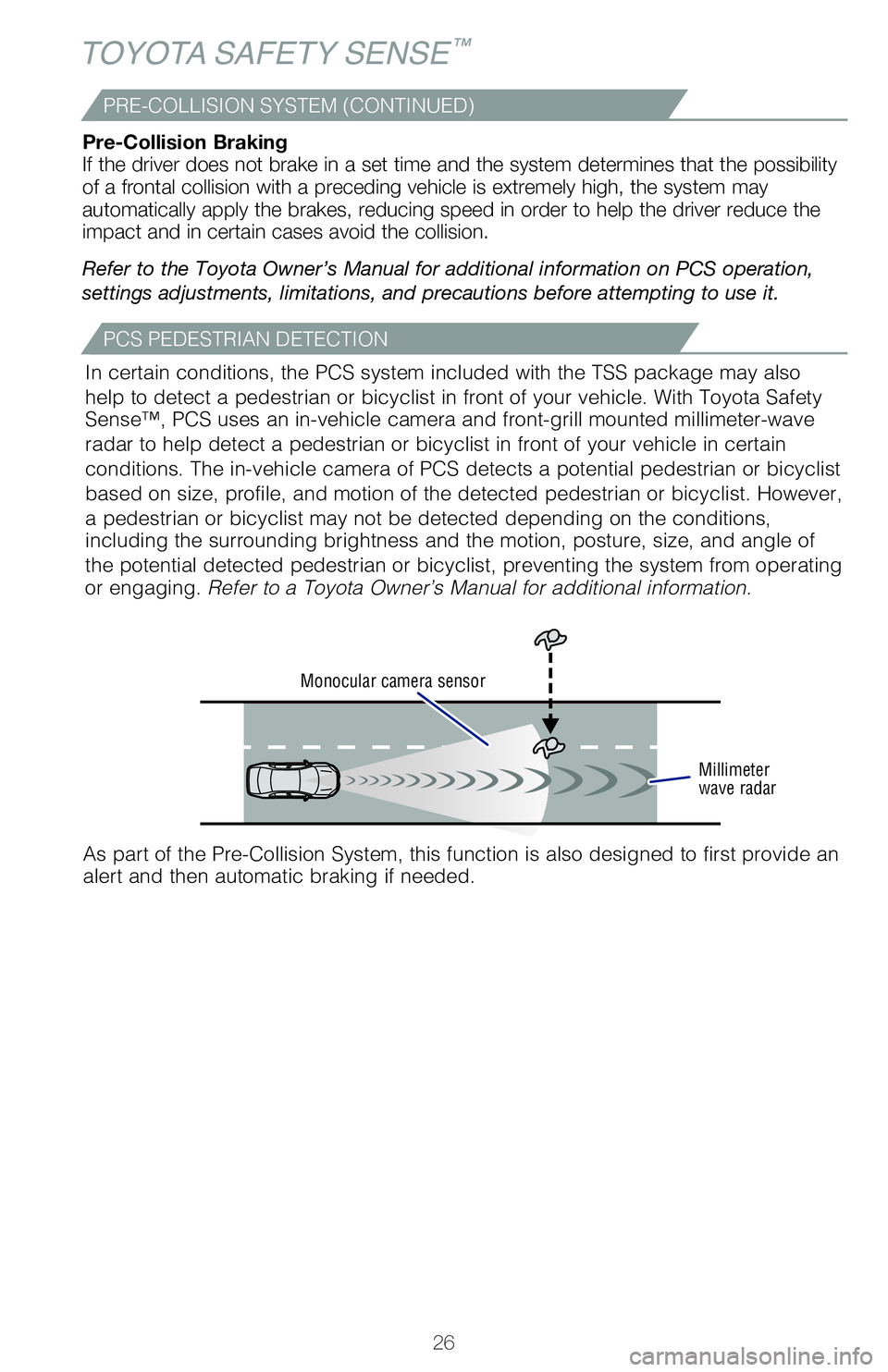
26
CHANGING PRE-COLLISION ALERT TIMINGPRE-COLLISION SYSTEM (CONTINUED)
DISABLING PRE-COLLISION SYSTEM (PCS)
Each time the PCS switch is pressed, the response to the PCS alert timin\
g changes.
TOYOTA SAFETY SENSE™
Refer to the Toyota Owner’s Manual for additional information on PCS \
operation,
settings adjustments, limitations, and precautions before attempting to \
use it. Pre-Collision Braking
If the driver does not brake in a set time and the system determines tha\
t the possibility
of a frontal collision with a preceding vehicle is extremely high, the s\
ystem may
automatically apply the brakes, reducing speed in order to help the driv\
er reduce the
impact and in certain cases avoid the collision.
Monocular camera sensorMillimeter
wave radar
As part of the Pre-Collision System, this function is also designed to f\
irst provide an
alert and then automatic braking if needed.In certain conditions, the PCS system included with the TSS package may \
also
help to detect a pedestrian or bicyclist in front of your vehicle. With \
Toyota Safety
Sense™, PCS uses an in-vehicle camera and front-grill mounted millime\
ter-wave
radar to help detect a pedestrian or bicyclist in front of your vehicle \
in certain
conditions. The in-vehicle camera of PCS detects a potential pedestrian \
or bicyclist
based on size, profile, and motion of the detected pedestrian or bicycli\
st. However,
a pedestrian or bicyclist may not be detected depending on the condition\
s,
including the surrounding brightness and the motion, posture, size, and \
angle of
the potential detected pedestrian or bicyclist, preventing the system fr\
om operating
or engaging. Refer to a Toyota Owner’s Manual for additional information.
PCS PEDESTRIAN DETECTION
(1) Press “ ” switches and select from the Multi-Information Display (MID).
(2) Press “ ” switches and select
from the MID and then press
“”. The setting screen is displayed.
(3) Press “
” each time to change the setting. Each time it is pressed, the
response to the PCS alert timing changes as shown above. You can press “\
” to
go back to the menu.
Note: PCS is enabled each time the engine switch is turned to Ignition On.
The system can be disabled/enabled and the alert timing of the system can be
changed. (Alert timing only, brake operation remains the same).
(1) Press “ ” switches and select
from the Multi-Information Display (MID).
(2) Press “ ” and “
” switches to change the setting.
(3) Press “
” to go back to the menu.
Note: The system is enabled each time the power switch is turned to ON
mode.
Refer to a Toyota Owner’s Manual for additional information on PCS op\
eration,
settings adjustments, limitations, and precautions before attempting to \
use it.
2019_Corolla_HB_QRG_V5_0516.indd 265/17/18 11:12 PM
Page 38 of 56

36
TURNING SYSTEM ON/OFF
ADJUSTING SET SPEED
(3)
(1)
Push once: On
Push twice: Off
(2)
TOYOTA SAFETY SENSE™
ADJUSTING DISTANCE
This mode employs a radar sensor to detect the presence of a preceding v\
ehicle
up to approximately 328 ft (100m) ahead, determines the current vehicl\
e-to-vehicle
following distance and operates to maintain a preset following distance \
from the
vehicle ahead. These distances vary based on vehicle speed.
(1) Constant speed cruising when there are no vehicles ahead
The vehicle travels at the speed set by the driver. The desired vehicle-\
to-
vehicle distance can also be set by operating the vehicle-to-vehicle dis\
tance
control.
(2) Deceleration cruising and follow-up cruising when a preceding vehicle
driving slower than the set speed appears When a vehicle is detected running ahead of you, the system automaticall\
y
decelerates your vehicle. When a greater reduction in vehicle speed is
necessary, the system applies the brakes (the brake lights will come on\
at this
time). The system will respond to changes in the speed of the vehicle a\
head
in order to maintain the vehicle-to-vehicle distance set by the driver. \
A warning
tone warns you when the system cannot decelerate sufficiently to prevent\
your
vehicle from closing in on the vehicle ahead.
Note: Vehicle-to-vehicle distance will close in when traveling on long downhill
slopes.
1 The set speed may be resumed once vehicle speed exceeds 25 mph.2 The set speed may also be cancelled by depressing the brake pedal.
Dynamic Radar Cruise Control (DRCC)* or
Full-Speed Range DRCC**
DRCC helps maintain a pre-set distance to a preceding vehicle when the p\
receding
vehicle is traveling at a lower speed. This mode is always selected firs\
t when the
cruise control button is depressed. Constant speed cruise control mode i\
s also
available. Full-Speed Range DRCC is designed to function at speeds betwe\
en 0 to
approximately 110 MPH and is intended for highway use.
Display
Set speed Dynamic Radar Cruise Control
vehicle-to-vehicle distance button
Cruise control
switch
Indicators
Refer to page 38 for switching to Constant Speed (Cruise) Control Mode\
.
Vehicle will cruise at a set speed, decelerate to maintain selected dist\
ance from a
slower vehicle traveling in front and accelerate back up to the selected\
speed if the
vehicle in front changes lanes or speeds up.
(1) Push “
” to turn DRCC system ON.
(2) Use the steering wheel controls to increase speed by pushing “+RES” or
decrease the speed by pushing “-SET”. Push and hold to make a large
adjustment or push each time to make fine adjustments (1 mph [1.6 km/h]\
or 1
km/h [0.6 mph] increments).
(3) Push “Cancel” to cancel the adjusting speed operation.
Increase speed/Resume1
Cancel2
Decrease speed
* Manual transmission, ** Continuously variable transmission
2019_Corolla_HB_QRG_V5_0516.indd 365/17/18 11:12 PM
Page 39 of 56
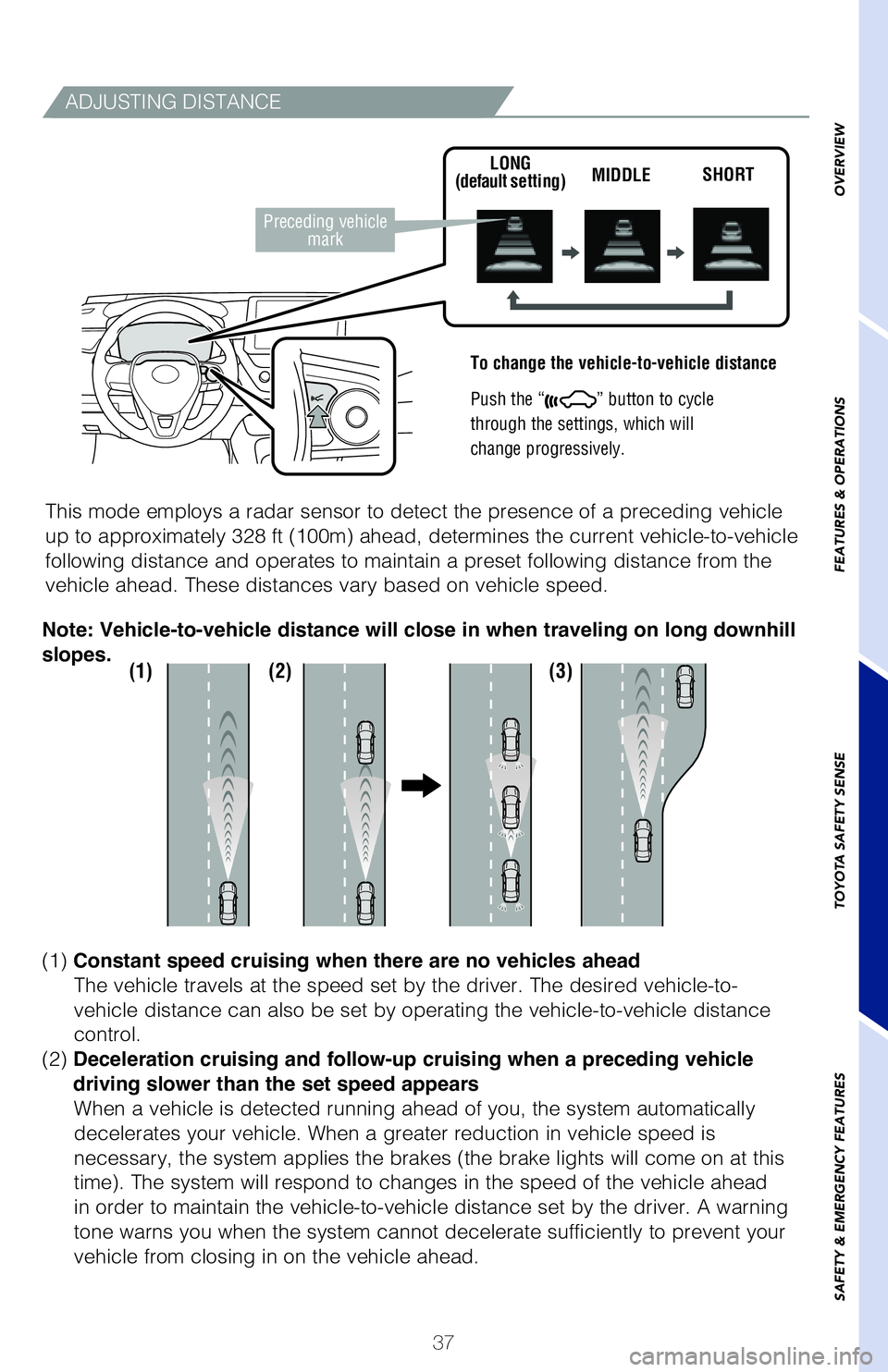
37
ADJUSTING DISTANCE
To change the vehicle-to-vehicle distance
Push the “
” button to cycle
through the settings, which will
change progressively.
This mode employs a radar sensor to detect the presence of a preceding v\
ehicle
up to approximately 328 ft (100m) ahead, determines the current vehicl\
e-to-vehicle
following distance and operates to maintain a preset following distance \
from the
vehicle ahead. These distances vary based on vehicle speed.
LONG
(default setting) MIDDLE
SHORT
(1) (2) (3)
(1) Constant speed cruising when there are no vehicles ahead
The vehicle travels at the speed set by the driver. The desired vehicle-\
to-
vehicle distance can also be set by operating the vehicle-to-vehicle dis\
tance
control.
(2) Deceleration cruising and follow-up cruising when a preceding vehicle
driving slower than the set speed appears When a vehicle is detected running ahead of you, the system automaticall\
y
decelerates your vehicle. When a greater reduction in vehicle speed is
necessary, the system applies the brakes (the brake lights will come on\
at this
time). The system will respond to changes in the speed of the vehicle a\
head
in order to maintain the vehicle-to-vehicle distance set by the driver. \
A warning
tone warns you when the system cannot decelerate sufficiently to prevent\
your
vehicle from closing in on the vehicle ahead.
Note: Vehicle-to-vehicle distance will close in when traveling on long downhill
slopes.
1 The set speed may be resumed once vehicle speed exceeds 25 mph.2 The set speed may also be cancelled by depressing the brake pedal.
Preceding vehicle
mark
Dynamic Radar Cruise Control (DRCC)* or
Full-Speed Range DRCC**
DRCC helps maintain a pre-set distance to a preceding vehicle when the p\
receding
vehicle is traveling at a lower speed. This mode is always selected firs\
t when the
cruise control button is depressed. Constant speed cruise control mode i\
s also
available. Full-Speed Range DRCC is designed to function at speeds betwe\
en 0 to
approximately 110 MPH and is intended for highway use.
Dynamic Radar Cruise Control
vehicle-to-vehicle distance button
Cruise control
switch
Refer to page 38 for switching to Constant Speed (Cruise) Control Mode\
.
Vehicle will cruise at a set speed, decelerate to maintain selected dist\
ance from a
slower vehicle traveling in front and accelerate back up to the selected\
speed if the
vehicle in front changes lanes or speeds up.
(1) Push “
” to turn DRCC system ON.
(2) Use the steering wheel controls to increase speed by pushing “+RES” or
decrease the speed by pushing “-SET”. Push and hold to make a large
adjustment or push each time to make fine adjustments (1 mph [1.6 km/h]\
or 1
km/h [0.6 mph] increments).
(3) Push “Cancel” to cancel the adjusting speed operation.
OVERVIEW
FEATURES & OPERATIONS
TOYOTA SAFETY SENSE
SAFETY & EMERGENCY FEATURES
* Manual transmission, ** Continuously variable transmission
2019_Corolla_HB_QRG_V5_0516.indd 375/17/18 11:12 PM
Page 48 of 56
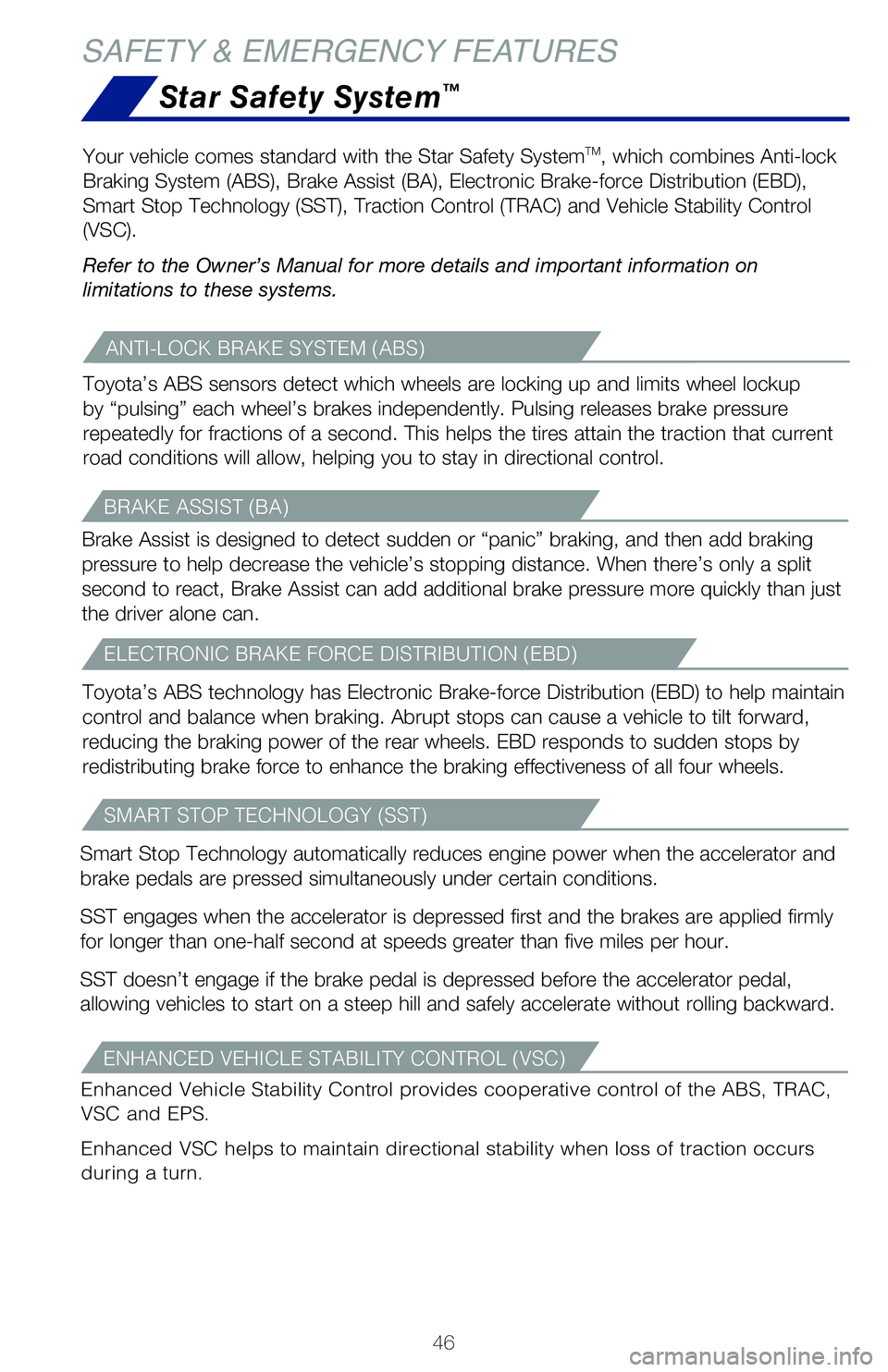
46
SAFETY & EMERGENCY FEATURES
There are two types of Toyota floor mats: carpeted and all-weather. Each\
vehicle has
model-specific floor mats. Installation is easy.
To keep your floor mat properly positioned, follow these steps:
• Only use Toyota floor mats designed for your specific model.
• Use only one floor mat at a time, using the retaining hooks to keep\
the mat in place.
• Install floor mats right side up.
VSC helps prevent loss of traction during cornering by reducing engine p\
ower, and
Traction Control helps maintain traction on loose gravel and wet, icy, o\
r uneven
surfaces by applying brake force to the spinning wheel(s).
Toyota’s TRAC sensors are activated when one of the drive wheels star\
ts to slip. TRAC
limits engine output and applies the brakes to the spinning wheel. This \
transfers power
to the wheels that still have traction to help keep you on track.
TRACTION CONTROL (TRAC)Star Safety System™
Your vehicle comes standard with the Star Safety SystemTM, which combines Anti-lock
Braking System (ABS), Brake Assist (BA), Electronic Brake-force Dist\
ribution (EBD),
Smart Stop Technology (SST), Traction Control (TRAC) and Vehicle Sta\
bility Control
(VSC).
Refer to the Owner’s Manual for more details and important informatio\
n on
limitations to these systems.
Toyota’s ABS sensors detect which wheels are locking up and limits wh\
eel lockup
by “pulsing” each wheel’s brakes independently. Pulsing release\
s brake pressure
repeatedly for fractions of a second. This helps the tires attain the tr\
action that current
road conditions will allow, helping you to stay in directional control. \
ANTI-LOCK BRAKE SYSTEM (ABS)
Brake Assist is designed to detect sudden or “panic” braking, and \
then add braking
pressure to help decrease the vehicle’s stopping distance. When there\
’s only a split
second to react, Brake Assist can add additional brake pressure more qui\
ckly than just
the driver alone can.
BRAKE ASSIST (BA)
Toyota’s ABS technology has Electronic Brake-force Distribution (EBD\
) to help maintain
control and balance when braking. Abrupt stops can cause a vehicle to ti\
lt forward,
reducing the braking power of the rear wheels. EBD responds to sudden st\
ops by
redistributing brake force to enhance the braking effectiveness of all f\
our wheels.
ELECTRONIC BRAKE FORCE DISTRIBUTION (EBD)
ENHANCED VEHICLE STABILITY CONTROL (VSC)
Enhanced Vehicle Stability Control provides cooperative control of the A\
BS, TRAC,
VSC and EPS.
Enhanced VSC helps to maintain directional stability when loss of tracti\
on occurs
during a turn.
Smart Stop Technology automatically reduces engine power when the accele\
rator and
brake pedals are pressed simultaneously under certain conditions.
SST engages when the accelerator is depressed first and the brakes are a\
pplied firmly
for longer than one-half second at speeds greater than five miles per ho\
ur.
SST doesn’t engage if the brake pedal is depressed before the acceler\
ator pedal,
allowing vehicles to start on a steep hill and safely accelerate without\
rolling backward.
SMART STOP TECHNOLOGY (SST)
2019_Corolla_HB_QRG_V5_0516.indd 465/17/18 11:12 PM
Page 49 of 56
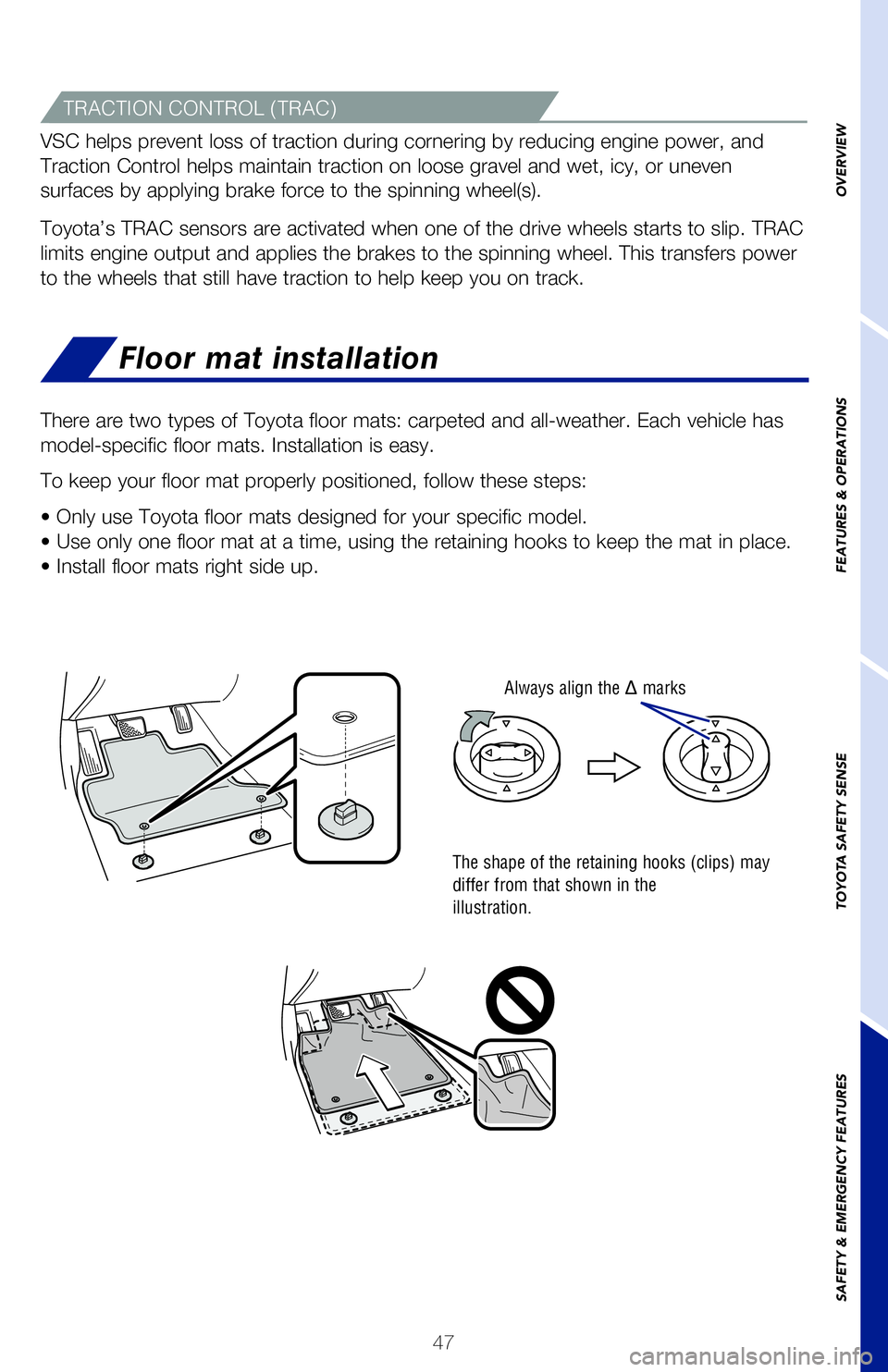
47
OVERVIEW
FEATURES & OPERATIONS
TOYOTA SAFETY SENSE
SAFETY & EMERGENCY FEATURES
Floor mat installation
There are two types of Toyota floor mats: carpeted and all-weather. Each\
vehicle has
model-specific floor mats. Installation is easy.
To keep your floor mat properly positioned, follow these steps:
• Only use Toyota floor mats designed for your specific model.
• Use only one floor mat at a time, using the retaining hooks to keep\
the mat in place.
• Install floor mats right side up.
The shape of the retaining hooks (clips) may
differ from that shown in the
illustration.
Always align the marks
VSC helps prevent loss of traction during cornering by reducing engine p\
ower, and
Traction Control helps maintain traction on loose gravel and wet, icy, o\
r uneven
surfaces by applying brake force to the spinning wheel(s).
Toyota’s TRAC sensors are activated when one of the drive wheels star\
ts to slip. TRAC
limits engine output and applies the brakes to the spinning wheel. This \
transfers power
to the wheels that still have traction to help keep you on track.
TRACTION CONTROL (TRAC)
Your vehicle comes standard with the Star Safety SystemTM, which combines Anti-lock
Braking System (ABS), Brake Assist (BA), Electronic Brake-force Dist\
ribution (EBD),
Smart Stop Technology (SST), Traction Control (TRAC) and Vehicle Sta\
bility Control
(VSC).
Refer to the Owner’s Manual for more details and important informatio\
n on
limitations to these systems.
Toyota’s ABS sensors detect which wheels are locking up and limits wh\
eel lockup
by “pulsing” each wheel’s brakes independently. Pulsing release\
s brake pressure
repeatedly for fractions of a second. This helps the tires attain the tr\
action that current
road conditions will allow, helping you to stay in directional control. \
Brake Assist is designed to detect sudden or “panic” braking, and \
then add braking
pressure to help decrease the vehicle’s stopping distance. When there\
’s only a split
second to react, Brake Assist can add additional brake pressure more qui\
ckly than just
the driver alone can.
Toyota’s ABS technology has Electronic Brake-force Distribution (EBD\
) to help maintain
control and balance when braking. Abrupt stops can cause a vehicle to ti\
lt forward,
reducing the braking power of the rear wheels. EBD responds to sudden st\
ops by
redistributing brake force to enhance the braking effectiveness of all f\
our wheels.
Enhanced Vehicle Stability Control provides cooperative control of the A\
BS, TRAC,
VSC and EPS.
Enhanced VSC helps to maintain directional stability when loss of tracti\
on occurs
during a turn.
Smart Stop Technology automatically reduces engine power when the accele\
rator and
brake pedals are pressed simultaneously under certain conditions.
SST engages when the accelerator is depressed first and the brakes are a\
pplied firmly
for longer than one-half second at speeds greater than five miles per ho\
ur.
SST doesn’t engage if the brake pedal is depressed before the acceler\
ator pedal,
allowing vehicles to start on a steep hill and safely accelerate without\
rolling backward.
2019_Corolla_HB_QRG_V5_0516.indd 475/17/18 11:12 PM